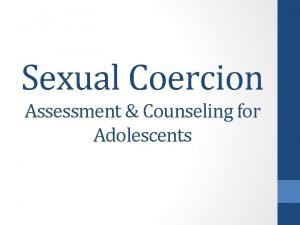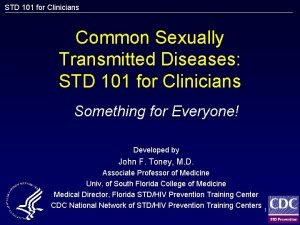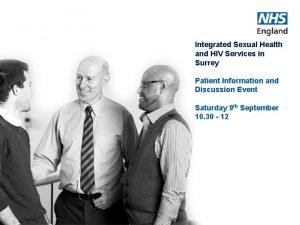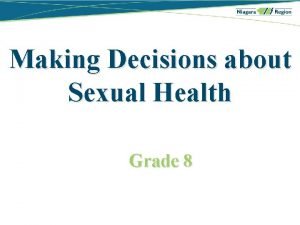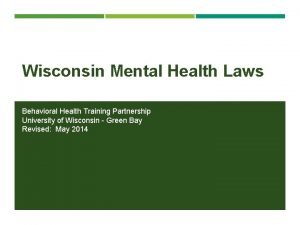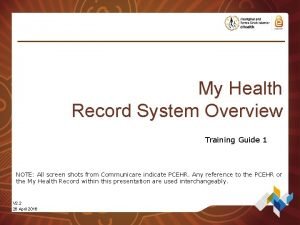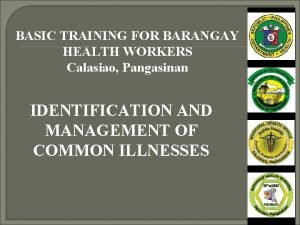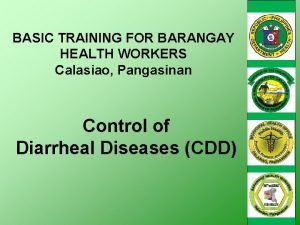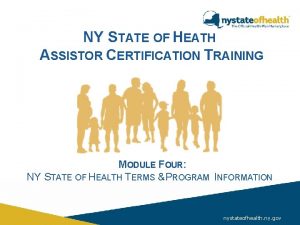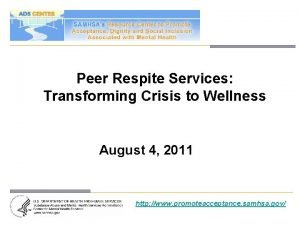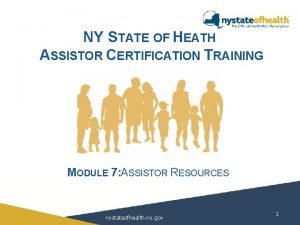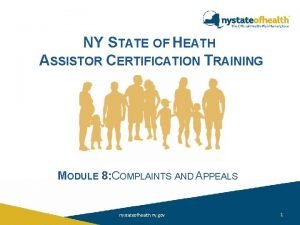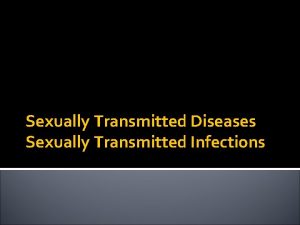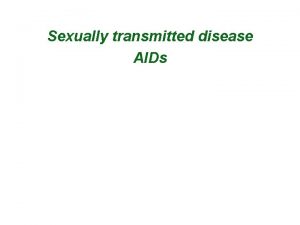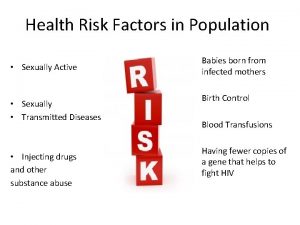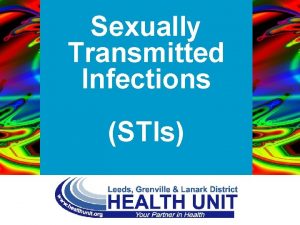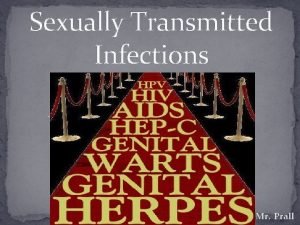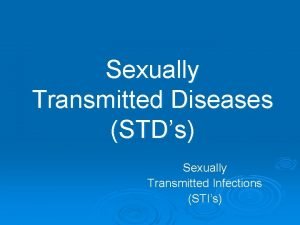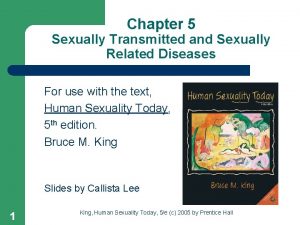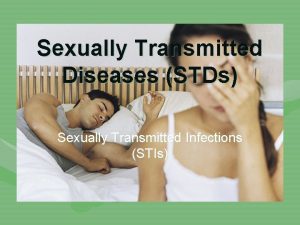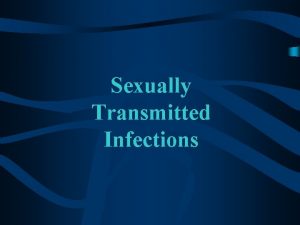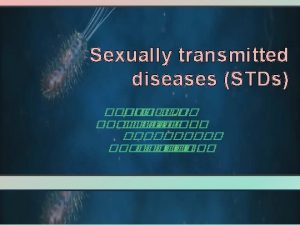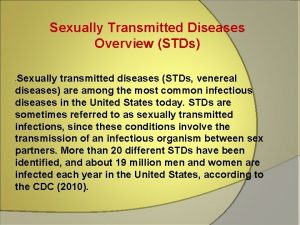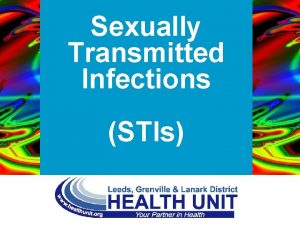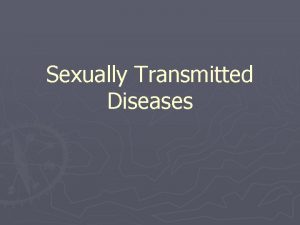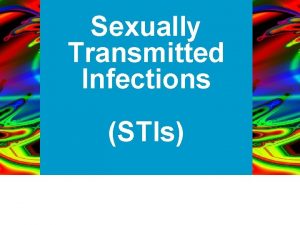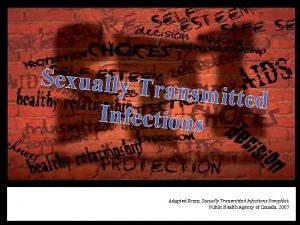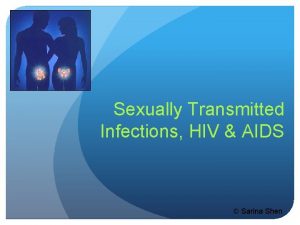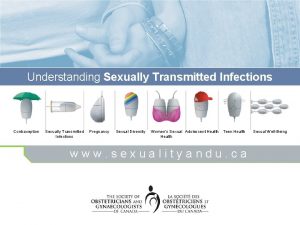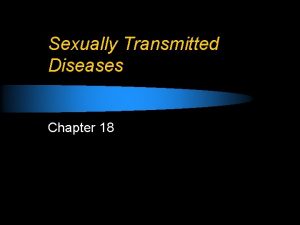Sexual Health Training What is Sexual Health Sexually



















































- Slides: 51

Sexual Health Training

• What is Sexual Health? • Sexually Transmitted Infections- how they are transmitted What This Guide Will Cover: • Sexually Transmitted Infections – who is most at risk • Sexually Transmitted Infections - symptoms and treatment • Taking Care of Sexual Health – Online and Treatment Clinic • Streetlight Self-care Kit • Links to Sexual Health Clinics

What is Sexual Health? • According to the current working definition, sexual health is: • “A state of physical, emotional, mental and social well-being in relation to sexuality; it is not merely the absence of disease, dysfunction or infirmity. Sexual health requires a positive and respectful approach to sexuality and sexual relationships, as well as the possibility of having pleasurable and safe sexual experiences, free of coercion, discrimination and violence. For sexual health to be attained and maintained, the sexual rights of all persons must be respected, protected and fulfilled. ” (WHO, 2006 a)

How Sexually Transmitted Infections are Transmitted • Sexually Transmitted Infections (STIs) ( previously known as Sexually Transmitted Diseases S. T. D’s) — are generally acquired by sexual contact. • How are they transmitted? • Blood, semen, or vaginal and other bodily fluids. • From mother to infant during pregnancy or childbirth. • Blood transfusions or shared needles.

HOW MANY?

Sexually Transmitted Infections: Symptoms • Sexually Transmitted Infections (STIs) can have a range of signs and symptoms but equally there can be N 0 SYMPTOMS. • That is why they may go unnoticed until complications occur or a partner is diagnosed. • Signs and symptoms may appear a few days after exposure, or it may take years before you have any noticeable problems, depending on the organism.

Sexually Transmitted Infections: High Risk Groups • Women in prostitution • Sex Buyers • Men who have sex with men • People from ‘high risk countries’: Sub-Saharan Africa, South-East Asia, Latin America/Caribbean • People with multiple partners, or partners from other high risk group • Young people aged 18 -25 used to be higher carriers of STI’s but STI clinics are now finding people aged 40+ to be higher carriers as they had less sex education/less knowledge re. sexual health

Why are Women in Prostitution at Higher Risk • They will have multiple partners who they do not know the sexual history of, which comes with an increased risk of contracting an STI. • They are likely to use barrier methods to protect themselves (such as condoms) for vaginal sex or anal sex, but may provide unprotected oral sex. Oral sex is a transmission route for most STIs and MANY women in prostitution advertise “OWO” (oral without). • Condoms are excellent barriers against infection, but there is still a small risk of passing on infection and this risk is increased with multiple partners.

• Is the most common STI, caused by a bacterium • It can affect the urethra, cervix, uterus, fallopian tubes, testicles, rectum, throat, and eyes. • It can be caught through unprotected sex ( using no condom ) whether vaginal, oral or anal sex ( or sharing sex toys ) with someone who has chlamydia. Chlamydia • From an infected mother to her baby during childbirth ( vaginal delivery ) • Sometimes from genitals to fingers to eyes, causing painful, red eyes ( conjunctivitis ) • Chlamydia cannot be caught by kissing, hugging, sharing baths or towels, using swimming pools or from toilet seats.

SYMPTOMS Some women may notice • Bleeding between periods or after having sex • Burning when passing urine • A change in the appearance and / or amount of vaginal discharge Some men may notice • Burning feeling or pain when passing urine • Discharge from their penis.

• If left untreated in women, Chlamydia may lead to PID ( Pelvic Inflammatory Disease ) • PID increases the risk of infertility and / or ectopic pregnancy ( a pregnancy that occurs outside the womb, usually in one of the fallopian tubes ) • In men Chlamydia can spread from the urethra to the testicles causing pain and / or swelling of the testicles. • In rare cases chlamydia may cause pain and swelling in joints such as the ankles or knees. This is known as sexually acquired reactive arthropathy (SARA) and is more common in men.

• TESTING • For women, Chlamydia is tested for using a swab. • For men, a urine sample is taken. • TREATMENT • Chlamydia is easily treated with antibiotics

It is the second most common bacterial STI in the UK It can be caught GONORRHOEA • through unprotected vaginal, anal or oral sex (or sharing sex toys) with someone that has gonorrhoea. • From an infected mother to her baby at birth • Sometimes from genitals to fingers to eyes where it may cause an eye infection ( conjunctivitis) Gonorrhoea cannot be caught by kissing, or from swimming pools, saunas or toilet seats.

Symptoms Some women may notice • Bleeding between periods or after sex • Lower abdominal pain particularly during sex • ‘ cystitis ‘ or burning pain when passing urine • Increased vaginal discharge Men will usually notice • A discharge from the penis • A burning pain when passing urine

• Symptoms in men usually appear within 2 – 5 days of catching the infection. Infections in the throat or rectum usually go unnoticed. • If left untreated in women Gonorrhoea can lead to the spread of infection to the reproductive organs possibly leading to infertility. • In men the spread of infection to the testicles can lead to pain and swelling.

• TESTING • For women Gonorrhoea is tested for using a swab • For men a urine sample is taken. ( Swabs are taken when a person presents with symptoms ) • TREATMENT • Gonorrhoea can be easily treated with a single dose combination of antibiotics – one is usually given by injection.

Is caused by a bacterium It is not common in the UK Syphilis is passed on • Through unprotected vaginal, anal or oral sex with someone who has syphilis SYPHILIS • By touching ulcers or weeping rashes in someone who has syphilis • Through blood transfusions, although this is very rare in the UK • From an infected mother to her unborn baby Syphilis cannot be caught by hugging, sharing baths or towels, from swimming pools, toilet seats or sharing cups, plates or cutlery.

Symptoms Some people do notice anything wrong, and the infection is discovered only when they have a blood test. Some develop one or more of the following • Ulcers on the genitals, near the anus or in the mouth • A skin rash • Swollen lymph glands, for example in the groin or neck. Symptoms may occur as early as a week after infection, but sometimes it takes many months before the person notices a problem. If Syphilis is not treated there is a risk of damage to the nervous system ( the brain, spinal cord and nerves) as well as the heart. These complications may take many years to develop and happen very rarely in this country because the treatment works so well. TREATMENT Syphilis can be treated with antibiotics, usually with a number of injections.

TV is a protozoon. Protozoa are tiny organisms similar to bacteria. TRICHOMONAS ( TV ) TV is passed on • Through unprotected vaginal sex, insertion of fingers into the vagina or sharing sex toys with someone who has TV It cannot be caught from hugging, sharing baths or towels, swimming pools or toilet seats.

Symptoms Women may notice anything wrong but they can still pass on TV to their sexual partner. Some women may notice one or more of the following • Increased vaginal discharge • An unpleasant vaginal smell • ‘cystitis’ or burning pain when passing urine • Vulval itching or soreness • Pain in the vagina during sex Most men will not feel anything wrong but they can still pass TV on to their sexual partner.

Testing and Treatment In women • It is not a routine test in all clinics but is usually done if a person has symptoms. A swab is taken and looked at under a microscope. A sample can also be sent off to the laboratory. In men • It is not a routine test and men usually are tested because their sexual partner has tested positive. A swab can be taken, or a urine sample can be sent to the laboratory. Most of the tests for TV do not work very well in men and this explains why most men with TV will test negative. TV can be easily treated with antibiotics.

• Genital warts are the most common STI caused by a virus • Warts are caused by human papillomaviruses ( HPVs ) GENITAL WARTS • Although there are over a hundred different types of HPV, most genital warts are caused by HPV 6 and HPV 11. Warts on the fingers or soles of the feet ( verrucas ) are caused by different HPVs which do not spread to the genital skin. • Genital warts develop after direct skin to skin contact with someone who has HPV in their skin. • Warts cannot be caught from hugging, sharing baths, towels, sheets, toilet seats or swimming pools.

Symptoms Wart virus can create small lumps on the skin. Warts can vary in size, shape and colour. They can occur singly or in groups. They are not painful but they can itch and sometimes bleed if they are damaged. Some people do notice that they have warts because they are very small or because they are on parts of the skin which are difficult to see. Women may notice • Warts on the vulva and around the anus. Sometimes warts can develop inside the vagina or on the cervix. Men may notice • warts on the head or shaft of the penis or around the anus. Warts may also develop in the urethral meatus, in the skin covered by pubic hair and in the groins. Rarely, warts can occur in and around the mouth.

Testing and Treatment Warts are usually diagnosed by a doctor or nurse examining the skin. It is usually not possible to know when a person caught HPV. It is quite common to develop warts within 3 months of being infected with the virus, but it is possible to develop warts years after infection. Treatment can be done with creams or lotions which a person can use at home. Other treatments such as freezing or burning can only be done in sexual health clinics.

• Warts may disappear after 3 – 4 weeks of treatment. However, it can take longer. • People who have lots of warts or who have anal warts and smokers may all take longer to get rid of their warts. • People who have weakened immune systems and pregnant women can also take longer to get rid of their warts. • It is quite common for warts to come back, usually in the first three months after they have disappeared. In most cases this happens because there is still HPV in the skin. People who smoke are more likely to see their warts come back. • However, over time most people will get rid of HPV and will not develop new warts.

• It is extremely rare for warts to become cancerous. This is because the HPVs which cause most genital warts ( HPV 6 and HPV 11 ) are ‘low risk’ viruses. • The ‘high risk’ viruses are HPV 16 and 18 and these are responsible for the majority of the cervical cancers. • Using condoms offers some protection. • In the UK, girls and boys aged 12 – 13 are offered vaccination to prevent infection with HPVs 6, 11, 16 and 18. • Men who have sex with men, bisexual men and sex workers are also offered the vaccine.

It is caused by the Herpes Simplex Virus ( HSV ) GENITAL HERPES Herpes spreads by skin to skin contact, through touching or rubbing. Herpes cannot be caught from towels, swimming pools, saunas or from toilet seats. Herpes infection is very common.

Symptoms • Most people who catch herpes do not develop any sores and so don’t realise they have been infected. • In people who do develop sores, the first episode can last from a few days to several weeks. • Some people start with flu-like symptoms, followed by tiny bumps on the skin which turn into blisters or ulcers. The ulcers then slowly heal and scab over. The sores can be very painful. • In most people symptoms appear between two days and two weeks after catching the virus. However, some people develop sores months or even years after catching the virus.

Testing and Treatment • Herpes can be tested for by taking a swab from the blister or sore. • It is not always necessary to treat it. If it is the first episode a course of antiviral tablets may be helpful. • However, if the sores have been there for more than six days, the treatment probably won’t help as the person’s immune system will have started to kill the virus in the skin. • Painkillers such as paracetamol and anti-inflammatory tablets can be used to ease any pain.

• In some, but not all, people the herpes sores come back ( recur ) • Recurrences are usually much less painful. People may have a recurrent episode once or as often as once a month. • Recurrent episodes do not necessarily require treatment but for those people who experience regular recurrences antiviral treatment at the time of the episode or as suppressive therapy can be helpful. • HSV during pregnancy does not harm the baby but the woman may be advised to take antiviral medication in the last 4 weeks of her pregnancy so that she does not have an episode at the time of delivery, which could cause problems for the baby.

Hepatitis B is an infection of the liver caused by a virus that is spread through blood and body fluids. HEPATITIS B It is less common in the UK than other parts of the world, but certain groups are at an increased risk. • People originally from high risk countries • People who inject drugs • People who have unprotected sex with multiple partners, people who have sex with someone in or from a high risk area, men who have sex with men.

• Hep B can be spread by • A mother to her newborn baby • Injecting drugs and sharing needles and other drug equipment, such as spoons and filters • Unprotected sex with an infected person • Having a tattoo or body piercing, medical or dental treatment using non sterile equipment • Blood transfusions in countries where blood has not been tested for hepatitis

• Sharing toothbrushes or razors contaminated with infected blood • Needle stick injury where skin is punctured by a used needle • The blood of an infected person getting into an open wound, cut or scratch. In very rare cases being bitten by someone with Hep B. • Close contacts, such as family members, of someone with a long-term • ( chronic ) Hep B infection • Hepatitis B is not spread by kissing, holding hands, hugging, coughing, sneezing or sharing crockery and utensils.

• SYMPTOMS • Only some people with the virus experience symptoms, which usually develop 2 or 3 months after exposure to the virus. • Some people will have • Tiredness • General aches and pains • High temperature • General sense of feeling unwell • Loss of appetite • Sickness and diarrhea • Abdominal pain • Jaundice ( yellowing of skin and eyes ) • Dark urine and pale, grey coloured poo

Treatment and Complications • Depends on how long someone has been infected for • Acute (short term) Hep B does not usually need specific treatment, but may require treatment to relieve the symptoms • Chronic Hep B is often treated with medication to keep the virus under control • Emergency treatment can also be given soon after possible exposure to the virus to stop an infection developing. • Without treatment, people with chronic hepatitis can develop problems like scarring of the liver (cirrhosis) and cancer of the liver. A Hepatitis B vaccine is available for people at high risk.

• HUMAN IMMUNODEFICIENCY VIRUS( HIV ) • Is a virus that damages the cells in your immune system and weakens your ability to fight everyday infections and disease. • ACQUIRED IMMUNE DEFICIENCY SYNDROME( AIDS ) • Is the name used to describe a number of potentially lifethreatening infections and illnesses that happen when your immune system has been severely damaged by the HIV virus. • While AIDS cannot be transmitted from one person to another, the HIV virus can.

• Is found in the body fluids of an infected person – semen, vaginal and anal fluids, blood and breast milk. • It is a fragile virus and does not survive outside the body for long. HIV • It cannot be transmitted through sweat, urine or saliva. • The most common way of getting HIV in the UK is through having anal or vaginal sex without a condom. Other ways of getting HIV include • Sharing needles, syringes or other injecting equipment • Transmission from mother to baby during pregnancy, birth or breastfeeding.

• The chance of getting HIV through oral sex is very low and will be dependent on many things, such as whether the person has given or received oral sex and the oral hygiene of the person giving the oral sex. • HIV is not passed on through • Spitting • Kissing • Being bitten • Contact with unbroken, healthy skin • Being sneezed on • Sharing baths, towels or swimming pools • Mouth to mouth resuscitation • Contact with animals or insects like mosquitoes.

Symptoms • Most people (80%) experience a short flu-like illness 2 to 6 weeks after HIV infection, which lasts for a week or two. • After these symptoms disappear, HIV may not cause any symptoms for many years, although the virus continues to damage the immune system. • This process can vary from person to person, but may take up to 10 years, during which time the person will feel and appear well. • This means many people do not know they are infected.

Testing There are 3 main types of HIV test • Blood test – where a sample of blood is taken in a clinic and sent to a laboratory. Results are sometimes available on the same day or within a few days. • Point of care test (POCT) – where a sample of saliva or blood from a finger prick is taken in a clinic. The result is available within a few minutes. • Home sampling kit – where saliva or blood from a finger prick is collected and sent off in the post for testing. The result is given by phone or text in a few days.

• The blood test is the most accurate and can normally give a reliable result from 1 month after infection • The other tests are mostly accurate but may not give a reliable result for a longer period after exposure to the infection (12 weeks). This is known as the window period. • For all the tests a blood test should be carried out to confirm the result if the first test is positive.

There is currently no cure for HIV, but there are very effective drug treatments that enable people with the virus to live a long and healthy life. With an early diagnosis and effective treatment, most people with HIV will not develop any AIDS related illnesses and will live a near normal lifespan.

• Pr. EP is a daily tablet a person can take to help prevent them getting HIV if they are at high risk of contracting it. Pre Exposure Prophylaxis ( Pr. EP ) • Women involved in prostitution may be eligible for Pr. EP • It is available from some sexual health clinics on the NHS. It can also be bought privately. • People taking Pr. EP need ongoing regular monitoring including blood tests.

POSTEXPOSURE PROPHYLAXIS after SEXUAL EXPOSURE ( PEPSE ) PEPSE may significantly reduce a person’s risk of being infected with HIV after • being in contact with someone at high risk of being HIV positive • or who is known to be HIV positive • After sexual assault / rape PEPSE is • a combination of HIV drugs. It can help prevent the virus taking hold. A person should seek advice as soon as possible and certainly within 72 hrs ( ideally within 24 hrs ). It is available from larger sexual health clinics, the SARC and A/E.

Scabies is a very itchy skin condition caused by a tiny mite which is smaller than a pinhead. They are usually spread by direct skin to skin contact with someone who already has scabies and sometimes, but rarely, from shared clothing, towels or bedding. SCABIES Symptoms • Itchy rash which maybe a mixture of scratch marks and tiny red spots • Scratched areas may develop crusty sores which can become infected • The rash may cover much of the body but the mites are mainly found in the folds of skin between fingers and toes, palms of the hands, the wrists, ankles and soles of the feet, groins and breasts.

Treatment • Two applications of an insecticide cream or liquid one week apart • High temperature wash of clothes and bedding.

• Are tiny insects that live on coarse human hair, such as pubic hair Pubic Lice (crabs) • They can sometimes be found in other body hair but not in scalp hair • They are spread through close bodily contact such as sexual contact with an infected person • Other types of close bodily contact, such as hugging and kissing, can also spread the lice • It is also possible, though much rarer, for pubic lice to be spread through sharing clothes, towels and bedding.

Symptoms After getting pubic lice, it can take several weeks before symptoms appear. They may include • Itching in the infected areas, especially at night when the lice are most active. The itching is an allergic reaction to their saliva. • Inflammation and irritation caused by scratching • Black powder in underwear • Small spots of blood on thighs or lower abdomen caused by lice bites.

Treatment Application of insecticide cream or lotion to either the affected area or whole body. This usually needs to be repeated after 7 days to get rid of any lice that have hatched in that time. Clothes, towels and bedding need to be washed on a hot wash.

Sexually Transmitted Infections Genital Herpes Chlamydia Gonnorhea

Sexually Transmitted Infections Pubic Lice Genital Warts around Anus Trichomoniasis
 How do whales reproduce sexually
How do whales reproduce sexually Parasitism phylum
Parasitism phylum Invertebrates characteristics
Invertebrates characteristics Unokais
Unokais Coercion
Coercion Protista reproduction
Protista reproduction Sexual abuse quiz
Sexual abuse quiz Sea cucumber internal anatomy
Sea cucumber internal anatomy Do protists reproduce sexually
Do protists reproduce sexually Chapter 24 lesson 1 sexually transmitted diseases
Chapter 24 lesson 1 sexually transmitted diseases Ad sex
Ad sex Chapter 25 sexually transmitted infections and hiv/aids
Chapter 25 sexually transmitted infections and hiv/aids Chapter 24 sexually transmitted diseases and hiv/aids
Chapter 24 sexually transmitted diseases and hiv/aids How do annelids reproduce
How do annelids reproduce Sexual harassment quiz
Sexual harassment quiz Atis sexually or asexually
Atis sexually or asexually Class aves
Class aves Sexually transmitted diseases
Sexually transmitted diseases Radial symmetry
Radial symmetry Nursing management of reproductive tract infection
Nursing management of reproductive tract infection Frustrated freight definition
Frustrated freight definition Sexually transmitted disease
Sexually transmitted disease Pinacoderm
Pinacoderm How do birds reproduce
How do birds reproduce Sexual dimorphism
Sexual dimorphism Illinois sex offender management board
Illinois sex offender management board Louisiana sexual harassment training
Louisiana sexual harassment training Sexual harrasment prevention training
Sexual harrasment prevention training Wsu sexual harassment training
Wsu sexual harassment training Ceri evans
Ceri evans Buryfields sexual health clinic guildford
Buryfields sexual health clinic guildford What is sexual health
What is sexual health Sexual health
Sexual health Amy tishelman
Amy tishelman Sexual health and relationships education scotland
Sexual health and relationships education scotland Society of sexual health advisers
Society of sexual health advisers Training is expensive without training it is more expensive
Training is expensive without training it is more expensive Perbedaan on the job training dan off the job training
Perbedaan on the job training dan off the job training Aggression replacement training facilitator training
Aggression replacement training facilitator training Behavioral health training partnership
Behavioral health training partnership My health record training
My health record training Mental health documentation training
Mental health documentation training Paano nakakahawa ang leptospirosis
Paano nakakahawa ang leptospirosis Basic training for barangay health workers
Basic training for barangay health workers Basic training for barangay health workers
Basic training for barangay health workers We can talk mental health training
We can talk mental health training Basic training for barangay health workers
Basic training for barangay health workers Ny state of health assistor certification training
Ny state of health assistor certification training Ny state of health assistor certification training
Ny state of health assistor certification training Georgia mental health consumer network cps training
Georgia mental health consumer network cps training Nystateofhealth account
Nystateofhealth account Ny state of health assistor certification training
Ny state of health assistor certification training




